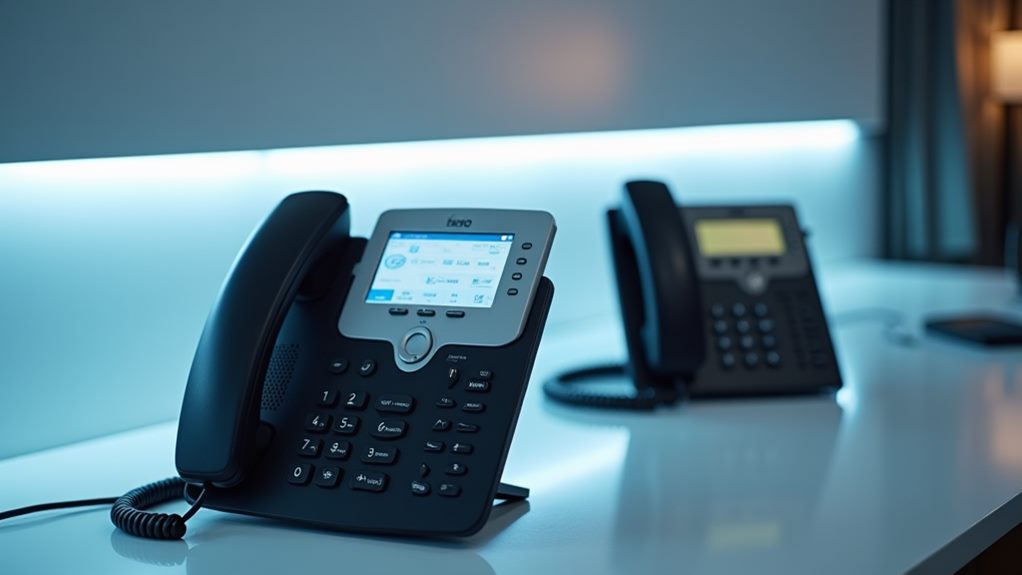VoIP can effectively replace your landline while offering enhanced features and cost savings. You'll need a reliable internet connection with at least 1 Mbps speed per line, though 3-5 Mbps is recommended for ideal quality. VoIP systems provide advanced capabilities like voicemail-to-email, video calling, and conference features at $8.97-$19.95 monthly, considerably less than traditional phone services. However, you'll want to take into account power outage solutions and emergency service access, as VoIP requires both electricity and internet connectivity to function. Battery backups and cellular failover options can address these potential limitations for a thorough communication solution.
Understanding VoIP Technology

Through modern technological advancements, VoIP has revolutionized telecommunications by transforming voice signals into digital data packets that traverse the internet. Unlike traditional landline phones that rely on copper wires, you'll find that VoIP operates entirely through your existing broadband connection, making it a cost-effective alternative for both homes and businesses. This technology utilizes open standards like SIP to guarantee seamless call setups, further enhancing its usability.
When you make VoIP calls, your voice is instantly converted into data that travels across digital phone lines, allowing for crystal-clear communication when your internet service is stable. You'll appreciate how VoIP technology enables you to connect through various devices – from your smartphone to your computer – giving you flexibility that conventional phones can't match.
This versatility means you're no longer tethered to a single location or device for your communications. The system's architecture supports advanced features you won't find with traditional phones, including seamless integration with digital applications and enhanced call management tools.
However, it's vital to understand that your VoIP service depends on a reliable internet connection, and you'll want to take into account backup options for emergency services access during potential outages.
Core Differences Between Systems
When you compare VoIP and landline systems, you'll find fundamental differences in their infrastructure, with VoIP utilizing IP networks and packet-switching technology while traditional landlines operate through circuit-switched copper networks.
This technological shift not only impacts operational costs but also enables VoIP to offer enhanced features that traditional systems can't match, such as unified communications and multi-device support at lower monthly rates than conventional landlines.
While VoIP systems excel in flexibility and features, you'll need to evaluate reliability factors, particularly during power outages and emergencies, where traditional landlines maintain functionality through independent power sources.
Connection Types and Infrastructure
The fundamental architecture of VoIP and traditional landline systems represents a technological paradigm shift in voice communication infrastructure. While you'll find traditional landline systems operating through dedicated copper wire networks within the PSTN, VoIP leverages your existing broadband internet connection to transmit calls over the internet. This distinction marks a significant evolution in how phone calls are processed and delivered.
VoIP, as a specialized mode of communication, emphasizes cost-effectiveness and integration with modern communication tools cost-effective solutions for users. When you're using VoIP, your voice is converted into digital data packets that travel across the internet infrastructure, requiring a stable internet access connection to maintain call quality. VoIP providers have optimized their systems to work across multiple devices, allowing you to make calls from your smartphone, computer, or dedicated VoIP phone. In contrast, traditional landline infrastructure restricts you to fixed locations and specific devices.
The ongoing global shift from PSTN to digital networks is reshaping customer service expectations and communication capabilities. You'll notice this change as major telecom providers phase out legacy systems by 2027, making VoIP infrastructure the new standard.
This transformation reflects the industry's move toward more flexible, cost-effective solutions that integrate with modern digital ecosystems.
Cost and Service Features
Cost structures and feature sets mark fundamental distinctions between VoIP and landline systems, building upon their infrastructural differences.
You'll find VoIP services typically range from $8.97 to $19.95 monthly, offering lower costs for long-distance calls compared to traditional landline rates. This pricing advantage extends to unlimited calling plans, making VoIP particularly attractive for high-volume users.
When you're evaluating advanced functionalities, VoIP delivers significant advantages through integration capabilities.
You'll gain access to voicemail-to-email conversion, seamless call forwarding, and video calling features that traditional landlines simply can't match. The ability to connect multiple devices to a single VoIP line means you're no longer tethered to a single physical location or handset.
Your business can benefit from VoIP's extensive customization options, allowing you to scale services as needed.
While you'll need a reliable broadband connection for peak performance, the trade-off brings substantial rewards in flexibility and feature accessibility.
Traditional landline systems, though dependable during internet outages, can't compete with VoIP's modern communication capabilities, leaving you potentially behind in today's digital business environment.
Reliability and Emergency Access
System reliability differences between VoIP and landline technologies present significant factors for emergency preparedness and operational continuity. While you'll find VoIP offers numerous advantages, traditional telephone systems maintain superior reliability during critical situations.
You'll notice that landlines continue functioning during power outages without requiring backup power sources, whereas VoIP systems depend on both electricity and internet connectivity to operate.
When you're evaluating emergency preparedness, landline's direct access to emergency services provides a significant advantage. You'll have immediate 911 connectivity through traditional telephone lines, independent of internet availability.
In contrast, your VoIP system's ability to reach emergency services relies on stable internet connections and power supply. Call quality also factors into reliability factors – your landline delivers consistent voice clarity, while VoIP call quality can fluctuate with network conditions.
You'll want to reflect on implementing redundancy measures if you're choosing VoIP, such as battery backups and emergency failover systems. However, you should understand that these solutions mightn't match the inherent stability of traditional telephone infrastructure, particularly during widespread outages or emergencies.
Internet Connection Requirements

You'll need a minimum internet speed of 1 Mbps for both upload and download to support basic VoIP functionality, though ideal performance typically requires faster speeds.
Your bandwidth requirements will increase proportionally with the number of simultaneous calls you plan to make, with each additional line consuming roughly 100 kbps of dedicated bandwidth.
For enterprise VoIP deployments, you should factor in a 20% overhead buffer above your calculated bandwidth needs to account for peak usage periods and maintain consistent call quality.
Minimum Speed For VoIP
Internet speed requirements play a significant role in determining VoIP call quality and performance. To guarantee reliable VoIP service, you'll need a minimum required download speed of 1 Mbps and upload speeds of at least 0.5 Mbps.
However, for peak performance and high-quality VoIP calls, you should aim for 3 Mbps download and 1 Mbps upload speeds.
If you're planning to handle simultaneous VoIP calls in your home or office, you'll need to account for additional bandwidth requirements. Each active call demands approximately 5 Mbps download and 1 Mbps upload capacity to maintain clear communication.
Furthermore, latency is essential for your VoIP experience – you'll want to keep it under 150 milliseconds to avoid delays and echoes during conversations.
Remember that a stable internet connection is just as important as raw speed. Even if you have high bandwidth, fluctuations in your connection can disrupt call quality and create frustrating interruptions.
When evaluating your internet service for VoIP compatibility, be sure to test both your connection's stability and speed to confirm you're equipped for reliable voice communications.
Bandwidth Usage Guidelines
Building upon the basic speed requirements, specific bandwidth guidelines help guarantee ideal VoIP performance across your network.
You'll need to allocate approximately 100 kbps per HD voice call, with a recommended internet speed of 3-5 Mbps per user to maintain consistent call quality. When multiple team members make simultaneous calls, your bandwidth requirements will increase proportionally.
To confirm your VoIP system operates at peak efficiency, you'll want to maintain a stable connection with low latency – keeping it under 100 milliseconds is vital for preventing call drops and maintaining clear communication.
Network congestion can greatly impact your call quality, especially during peak usage times when multiple devices compete for bandwidth. That's where implementing Quality of Service (QoS) settings on your router becomes essential. QoS prioritizes VoIP traffic over other data types, making sure your voice calls remain clear even when other applications are running.
Monitor your network's performance regularly and adjust your bandwidth allocation as needed.
Remember that while 1 Mbps might support a single call, investing in higher bandwidth capacity provides a buffer against potential quality issues and supports your organization's growth.
Emergency Service Considerations
When it comes to emergency services, VoIP systems present unique challenges that require careful consideration. Unlike traditional landlines, your VoIP services depend on an active internet connection to maintain communication with emergency responders. This means you'll need to plan for potential service interruptions during power outages or internet disruptions.
Before shifting to VoIP, you'll want to verify that your provider supports E911 services, which deliver essential location information to emergency response teams. While many providers offer this feature, it's not universal across all VoIP platforms.
You should also investigate battery backup options that can keep your system operational during power failures, as these solutions can provide vital redundancy for emergency situations.
It's important to align your communication needs with your provider's emergency service capabilities. Schedule a detailed discussion with potential VoIP providers to confirm their systems integrate properly with existing emergency response systems in your area.
You'll need to verify specific features like automatic location tracking and backup power solutions. Remember that your ability to reach emergency services could be compromised during internet outages, so consider maintaining a cellular backup for critical situations.
Cost Analysis and Savings

The cost differential between VoIP and traditional landline services presents compelling financial advantages for both residential and business users. When you analyze monthly fees, you'll find VoIP services typically range from $8.97 to $19.95, offering substantial savings compared to conventional landline rates.
This cost advantage becomes even more significant when you factor in unlimited calling plans to the US and Canada, effectively eliminating excessive long-distance call costs.
You'll benefit from VoIP's extensive feature set, which includes essential tools like voicemail-to-email, call forwarding, and conferencing capabilities at no additional charge. These same features often come with premium fees in traditional landline packages.
For your business operations, the change to VoIP can dramatically reduce hardware expenses through softphone implementation, minimizing the need for physical infrastructure and ongoing maintenance costs.
What's particularly remarkable in your cost analysis is VoIP's transparent pricing structure. You'll avoid the hidden fees commonly associated with traditional landline services, making your telecommunications budget more predictable and manageable.
This clarity in pricing, combined with lower operational costs, positions VoIP as a financially advantageous choice for your communication needs.
Equipment and Setup Process
Moving from cost considerations to practical implementation, setting up VoIP service requires specific hardware components and technical preparations. You'll need a reliable high-speed internet connection as your foundation, along with VoIP-enabled equipment or adapters to convert your traditional phones for internet-based calling.
Your VoIP providers will typically supply essential equipment, including specialized routers and handsets, often at minimal or no additional cost during initial setup. Before shifting, you'll need to conduct thorough compatibility checks to guarantee your existing devices, such as security systems and payment terminals, will function properly with the new VoIP service.
One significant advantage of modern VoIP setup is the availability of softphone applications. You can integrate these apps into your smartphones and computers, enabling you to make and receive calls from multiple devices.
The setup process isn't overly complex, and service providers offer extensive support to guide you through the shift. They'll help you configure your network settings, connect your devices, and guarantee maximum call quality.
If you're currently using traditional phone systems, you'll find that most VoIP providers have streamlined the migration process to minimize disruption to your communications.
Service Features and Capabilities

Releasing advanced capabilities, VoIP systems dramatically outperform traditional landlines through their extensive feature sets and enhanced functionality. You'll find sophisticated tools like voicemail-to-email conversion, seamless call forwarding, and conference calling capabilities that integrate directly with your business software – features that simply aren't available with conventional phone systems.
You'll experience better call quality through HD voice transmission, particularly when operating on stable internet connections. VoIP services offer unprecedented flexibility, allowing you to make calls from your smartphone, laptop, or desktop computer, unlike traditional landline systems that tie you to a single location.
With cost-effective plans, you're able to leverage unlimited calling options, making international calls and long-distance communication more affordable than ever. Your business can establish local presence across multiple regions using virtual numbers, eliminating the need for physical landline installations.
The mobile data functionality enables you to stay connected whether you're at the office, working remotely, or traveling. These advanced features, combined with thorough calling plans, create a communication ecosystem that adapts to your evolving needs while maintaining professional standards and operational efficiency.
Power Outage Solutions
While VoIP systems excel in features and functionality, power dependency remains a significant consideration for implementation planning. Unlike traditional landlines that operate independently of electrical power, your VoIP connection requires active power to maintain service. This fundamental difference necessitates strategic planning for backup communication solutions.
You'll need to implement battery backup systems to guarantee continuous connectivity during power outages. Many VoIP providers offer specialized battery units designed to maintain your service when the power fails. It's vital to evaluate these resilience solutions, particularly if you rely on your phone system for emergency services access.
You should consider investing in external battery backup systems that align with your specific needs and usage patterns. If you're classified as a vulnerable customer, your VoIP provider might offer complimentary resilience solutions to maintain your emergency services access.
Don't overlook the importance of having multiple backup options – including mobile devices as secondary communication methods. By proactively addressing power dependency issues, you'll guarantee your VoIP system remains operational during critical situations, maintaining the reliability you've come to expect from traditional landline service.
Final Thoughts
Much like upgrading from a horse-drawn carriage to a modern vehicle, you'll find VoIP represents the natural evolution of voice communication. While you'll need to evaluate factors like internet stability and backup power solutions, VoIP's advanced features, significant cost savings, and flexible deployment options make it a viable landline replacement for most users. Your decision hinges on analyzing your specific requirements against VoIP's technical parameters and infrastructure demands.

